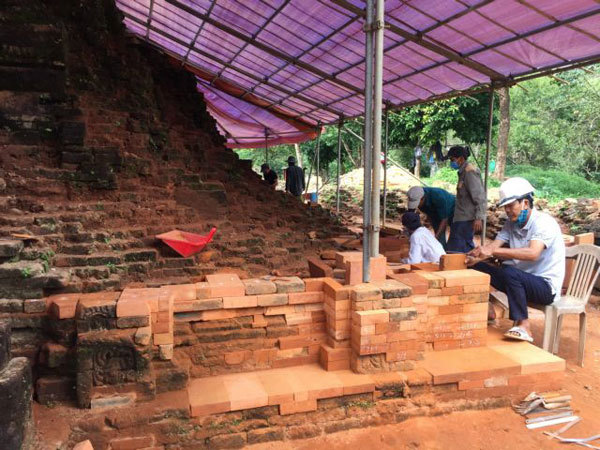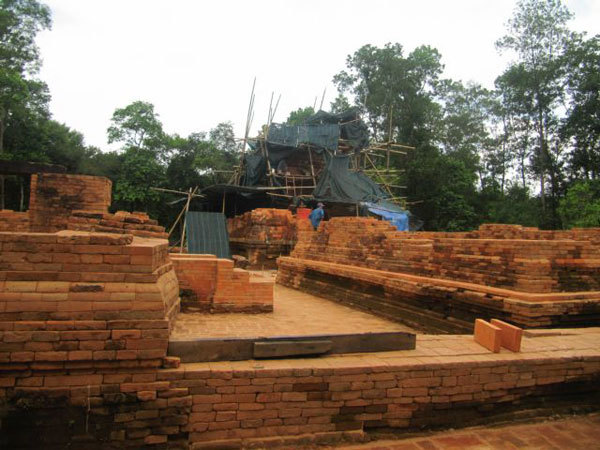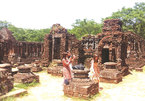while preparatory work has been scheduled on the remaining towers in Group A, as well as Groups K and H, once the COVID-19 pandemic has eased in the central region.
 |
| Workers restore brick works on a tower in group A at the My Son Sanctuary in Quang Nam Province. India's Government has funded restoration work on group A, H, K from 2017-21. Photo courtesy My Son Sanctuary Management board |
Deputy head of the My Son Sanctuary Heritage management board, Nguyen Cong Khiet, said Indian experts and Vietnamese workers have been working hard since last December on the foundation of A10 tower, an inner wall section, and outside walls on north and south of the tower.
Brick work and foundation restoration has been completed on A8 and A11 towers, while land clearance on group K and H has been prepared, he said.
Khiet said Indian experts began recovering towers of Groups K, A and H from 2017-21 with total funds of VND50 billion (US$2.1 million) from the Indian government.
Clay brick with natural resin (used by Cham people thousands of years ago) has been used to restore ruined brickwork of the towers, he added.
At least 70 temples and towers had been built between the 4th and 13th century, but just dozens of towers are still preserved at the site.
Different restoration projects have been implemented in preserving the UNESCO-recognised My Son Sanctuary.
The successful restoration of Group G monuments took place in 2003-13 by the Vietnam-Italy-UNESCO tripartite partnership with research into the construction techniques of the Cham people resulting from the restoration of monuments.
 |
| A brick foundation section of a tower is completed at the My Son Sanctuary. The UNESCO-recognised world heritage has been calling for more international co-operation in preserving the towers at the site. VNS Photo Cong Thanh |
Polish archaeologist and architect Kazimierz Kwiatkowski, known as ‘Kazik’, and a group of Polish archaeologists had strengthened ruined towers in Group B with cement, as well as clearing groups of towers in 1981-95.
Italian archaeologists then continued the restoration of Group G on the site from 1997 before Indian experts began recovering towers of Groups K, A and H from 2017-21.
The first excavation and research on the Cham towers began in 1898-99 by French archaeologists and researchers – Louis Finot and Launet de Lajongquere in 1901-02, and many artefacts found at the site were brought to the Cham Sculpture Museum in Da Nang City.
The My Son Sanctuary management board has called for international co-operation and investment in excavation and restoration of F1, F2, D1, D2 towers in preserving the unique and mysterious archaeological site as a research centre for Cham culture – a defunct civilisation in Asia. VNS

Mysteries of My Son Sanctuary unveiled through restoration
Situated in a peaceful valley surrounded by mountains, My Son Sanctuary has been well preserved since it was built thousands of years ago during the prosperous development of the Champa Kingdom between the 4th and 13th centuries.
 Up to eighty percent of restoration work on towers of Group A (A10, A8, A11) in the My Son Sanctuary has been completed, including the foundation, inner walls and boundary walls,
Up to eighty percent of restoration work on towers of Group A (A10, A8, A11) in the My Son Sanctuary has been completed, including the foundation, inner walls and boundary walls,